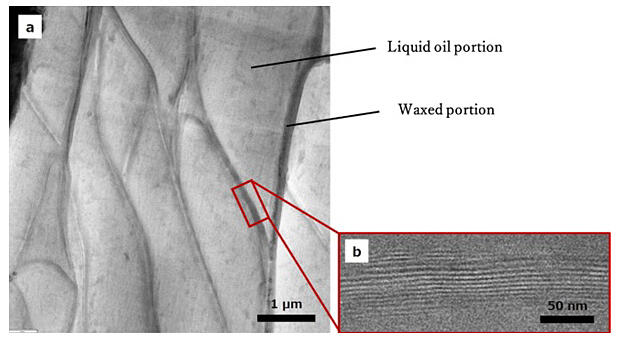Stick-type lipsticks are produced by blending pigments for color and pearls for shine into an oily base, such as wax or liquid oil. The hardness of a lipstick depends on the type and structure of the base and is thought to be substantially related to the feeling of use and stability of the formulation. Electron microscopes with high resolution are used to analyze this microscopic structure. Conventional observation methods require a vacuum state, which necessitates pre-treatment to remove liquid oil, making it impossible to observe the original structure of the lipstick.
In collaboration with Professor Hiroshi Jinnai of the Advanced Imaging and Modeling Center for Soft-materials at the Institute of Multidisciplinary Research for Advanced Materials, Tohoku University and other researchers, KOSÉ Corporation has developed a method to observe the microscopic structures of stick-type lipsticks using cryo-electron microscopy (cryo-EM) without component loss or structural changes. Because the original microscopic structure of lipstick can now be visualized, this method will be useful for formulation development and quality assurance. The findings were presented at the Annual Congress of the Society of Cosmetic Chemists of Japan.

Provided by KOSÉ
The research group focused on cryo-electron microscopy to observe the original structure of lipstick, including the liquid oil component. This technique allows the observation of samples at cryogenic temperatures, such as -196 ℃, without the need to remove components that volatilize in a vacuum, such as moisture. However, there were few examples of application to the observation of samples primarily composed of waxes and liquid oils.
With this in mind, the research group applied cryo-electron microscopy technology to analyze the microscopic structure of lipstick. They created a simple lipstick sample using only wax and liquid oil and observed it under cryo-electron microscopy conditions. Although several observational conditions were considered, thermal damage to the sample caused by the electron beam occurred in all cases, and clear images could not be obtained. After considering the properties of the oily sample, they were able to formulate conditions that suppress thermal damage and allow clear observation.
In the observation of the original microscopic structure of the lipstick obtained from this, a stripe-like structure in the wax portion was confirmed, for example. This may be attributed to the formation of a crystalline structure between the waxes within the lipstick and is one piece of evidence for what has been hypothesized in this field.
Next, they performed cryo-EM observations of lipsticks with added pigments, an essential component of lipsticks. While pigments add color, adding too much reduces the hardness of the lipstick, making it difficult to maintain the stick shape. To prevent crumbling during use, a balance is required in the amount of blending. Observations showed that adding pigment resulted in a finely branched structure in the wax portion, along with a reduction in thickness. This suggests that pigments may change the structure of the wax and make it brittle, thereby reducing the overall hardness of the lipstick.
If a method to control these structural changes is found, it will be possible to develop lipsticks in colors and shapes that were previously impossible.
This article has been translated by JST with permission from The Science News Ltd. (https://sci-news.co.jp/). Unauthorized reproduction of the article and photographs is prohibited.




